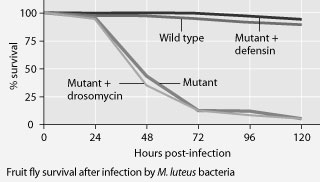Which secretion is not a barrier that prevents pathogens from entering the body?
Antigens.
True or false? The leukocytes of the innate immune system are B cells, macrophages, and neutrophils.
False
How do cells involved in the innate immune response detect the presence of pathogens?
Leukocytes recognize unique molecules on pathogens.
Which of the following cells can engulf a pathogen?
Macrophages.
Which of the following statements best describes the role of mast cells in the inflammatory response?
They release chemicals that dilate blood vessels near the wound site, allowing blood components to enter the region from the bloodstream.
Which of the following events occurs first when a wound that breaks the skin has occurred?
Platelets release proteins that form clots and decrease bleeding.
The site of inflammation may become swollen due to the increased numbers of cells and fluids at the site and painful due to signals from pain receptors.
True
Innate immunity and acquired immunity are both _____.
characteristics of all vertebrate animals
Macrophages are _____.
large, phagocytic cells that can leave the circulation and enter the tissues of the body
The cells and signaling molecules involved in the initial stages of the inflammatory response are _____.
mast cells and histamines
Inflammatory responses typically include _____.
increased activity of phagocytes in an inflamed area

Mutant fruit flies that make only one antimicrobial peptide were tested for survival after infection with Neurospora crassa fungi or with Micrococcus luteus bacteria.

adding the drosomycin gene to such mutants protects them from death by fungal infection
Acidity in human sweat is an example of _____.
innate immunity
An antigen _____.
is a foreign molecule that evokes a specific response by a lymphocyte
The fact that there are about a million different antigen receptors possible in human B cells is based on _____.
recombination of the segments of the receptor DNA that make up the functional receptor genes of differentiated B cells
Clonal selection is an explanation for how _____.
an antigen can provoke production of high levels of specific antibodies
Immunological memory accounts for _____.
the ancient observation that someone who had recovered from the plague could safely care for those newly diseased
How does an antihistamine reduce allergy symptoms?
An antihistamine blocks receptors for inflammatory chemicals released from granules within mast cells.
Lymphocytes mature in the _____.
I) spleen
II) thymus
III) bone marrow
only II and III
Vaccination increases the number of _____.
lymphocytes with receptors that can bind to the pathogen
What major advantage is conveyed by having a system of adaptive immunity?
It enables a rapid defense against an antigen that has been previously encountered.
Which of the following is a difference between B cells and T cells?
One has a major role in antibody production, while the other has a major role in cytotoxicity.
Cell-mediated immunity differs from humoral immunity in that _____.
they respond differently to invaders
Helper T cells are part of _____.
cell-mediated immune responses
A primary reason for needing a new vaccine for influenza each year is that _____.
mutation in the influenza virus is frequent